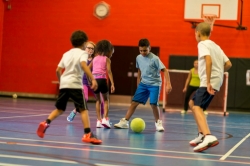Healthy Schools - Physical Education & Physical Activity
Why is physical activity imporant for students?
According to the U.S. Department of Health and Human Services, regular physical activity in childhood and adolescent improves strength and endurance. It helps build healthy bones and muscles and control weight. Physical activity can also reduce anxiety and stress while boosting self-esteem. It may even improve blood pressure and cholesterol levels. According to the U.S. Surgeon General, children should get 60 minutes of physical activity each day. Physical activity has many learning benefits for children such as:
- Brain function – physical activity can increase concentration and attentiveness in the classroom
- Wellness – physical activity can reduce feelings of depression and anxiety and promotes physiological wellbeing
- Body weight – physical activity burns calories, which together with a balanced diet, helps to maintain a healthy body weight
- Socialization – physical activity provides opportunities to learn social cues and develop interpersonal relationships
Why is physical education class important?
Physical education class is the study of physical activity based on national standards. Physical education class is standards-based, structured and sequenced. Physical education class develops motor skills, knowledge and behaviors for physical activity and physical fitness. The Centers for Disease Control and Prevention physical education webpage suggests physical education benefits students by:
- Increasing their level of physical activity,
- Improving their grades and standardized test scores, and
- Helping them stay on-task in the classroom.
Why is recess important?
Recess is regularly scheduled play breaks. Recess allows students to be physically active and practice their social skills with peers. According to the Centers for Disease Control and Prevention recess in schools webpage, recess benefits students by:
- Increasing their level of physical activity,
- Improving their memory, attention and concentration,
- Helping them stay on-task in the classroom,
- Reducing disruptive behavior in the classroom, and
- Improving their social and emotional development.

Government partners
Tennessee Department of Education
Coordinated School Health
www.tn.gov/education/health-and-safety/coordinated-school-health.html
Physical education standards
www.tn.gov/education/instruction/academic-standards/health-pe-wellness-standards.html
Health and Human Services
Office of Disease Prevention and Health Promotion
Move Your Way!
health.gov/moveyourway
Centers for Disease Control and Prevention
Healthy Schools
www.cdc.gov/healthyschools
Recess in Schools
www.cdc.gov/healthyschools/physicalactivity/recess.htm
Physical Education and Physical Acivity
www.cdc.gov/healthyschools/physicalactivity
Physical Activity Before and After School
www.cdc.gov/healthyschools/physicalactivity/pa-before-after.htm
Helpful documents
Health and Human Services
Office of Disease Prevention and Health Promotion
Physical Activity Guidelines for Americans
health.gov/paguidelines/second-edition
Centers for Disease Control and Prevention
Increasing Physical Education and Physical Activity: A Framework for Schools
www.cdc.gov/healthyschools/physicalactivity/pdf/17_278143-A_PE-PA-Framework_508.pdf
